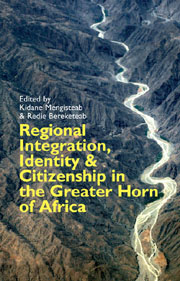Book contents
- Frontmatter
- Contents
- List of Tables, Figures & Appendices
- Notes on Contributors
- Acknowledgements
- List of Acronyms
- Part One RELEVANCE OF INTEGRATION TO IDENTITY AND CITIZENSHIP
- Part Two CRITICAL FACTORS IN INTEGRATION
- Part Three LESSONS FROM SELECTED AFRICAN INTEGRATION SCHEMES
- 8 Inter-Governmental Authority on Development (IGAD): A Critical Analysis
- 9 The East African Community: Can it be a Model for Africa's Integration Process?
- 10 The Economic Community of West African States (ECOWAS) and the Quest for Community Citizenship: Any Lessons for the Greater Horn Region?
- Index
- EASTERN AFRICAN STUDIES
9 - The East African Community: Can it be a Model for Africa's Integration Process?
from Part Three - LESSONS FROM SELECTED AFRICAN INTEGRATION SCHEMES
Published online by Cambridge University Press: 05 February 2013
- Frontmatter
- Contents
- List of Tables, Figures & Appendices
- Notes on Contributors
- Acknowledgements
- List of Acronyms
- Part One RELEVANCE OF INTEGRATION TO IDENTITY AND CITIZENSHIP
- Part Two CRITICAL FACTORS IN INTEGRATION
- Part Three LESSONS FROM SELECTED AFRICAN INTEGRATION SCHEMES
- 8 Inter-Governmental Authority on Development (IGAD): A Critical Analysis
- 9 The East African Community: Can it be a Model for Africa's Integration Process?
- 10 The Economic Community of West African States (ECOWAS) and the Quest for Community Citizenship: Any Lessons for the Greater Horn Region?
- Index
- EASTERN AFRICAN STUDIES
Summary
INTRODUCTION AND CONTEXT
Africa has a long history of regional integration, being one of the pioneers of initiatives of this nature. To highlight with concrete examples:
(a) The Congo Basin Treaty emerged from the Berlin conference of 1884.
(b) The seed of the first iteration of East African integration was sown in 1894 through the creation the Uganda-Kenya railway (see Appendix table 9.2).
(c) The Southern African Customs Union (SACU) was first signed by South Africa, Basutoland (now Lesotho), Swaziland, and Bechuanaland (now Botswana) at Potchefstroom on 29 July 1910.
(d) The Southern Rhodesia Customs Union between South Africa and present-day Zimbabwe was formed in 1949.
Regional integration resonated well amongst post-colonial African leaders, who saw it as a vehicle for development. Hence, in a process that resulted in the dissolution of some earlier experiments (only to be resurrected later), while other schemes were transformed, and new ones were initiated, the net effect was the proliferation of integration schemes.
Noteworthy attempts include the Trade Agreement between Ghana and Upper Volta (now Burkina Faso) of 1962; and the 1962 Equatorial Customs Union (ECU) that linked Cameroon, Central African Republic, Chad, Congo, and Gabon (see UNECA, 2004).
Generally, Africa has had more integration schemes than any other continent, with no fewer than twenty-four schemes being created or resurrected in the post-colonial era, of which six (see Appendix table 9.1) were also notified to the World Trade Organization (WTO).
- Type
- Chapter
- Information
- Publisher: Boydell & BrewerPrint publication year: 2012



